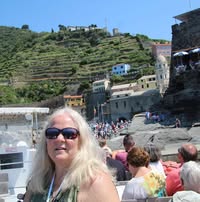Activity
Mon
Wed
Fri
Sun
Feb
Mar
Apr
May
Jun
Jul
Aug
Sep
Oct
Nov
Dec
Jan
What is this?
Less
More
Memberships
Gardeners Growing Together
284 members • Free
Travel Trainers
198 members • Free
119 contributions to Travel Trainers
Travel Advisor jobs are in the top 20 jobs growing in 2026!
I found this on LinkedIn, I’m curious about your thoughts.

Exoticca deals calling my name
Coming soon... Greece for less than $1,899/pp🥊💥 I’m eager for any trip in that kind of budget. 🙋♀️ But Greece? Guided? 😍 How about you?

2026 🎉🎉
As this year winds down, I want to pause for a minute. Not to rush into goals or planning yet, but to acknowledge what actually happened this year. For some of you, the win was simply surviving. And honestly, that counts. Full stop. For others, the wins were bigger. New clients, big bookings, clearer boundaries, stronger confidence, saying no more often, or finally feeling like you found your footing in your industry. All of it matters. There is something powerful about naming our wins and expressing gratitude for them. Not to brag. Not to compare. But because acknowledging what went right creates space for more growth, more clarity, and bigger opportunities in the year ahead. So let’s do this together. 👉 Share one win from this year you are proud of 👉 And one thing you are grateful for as we head into the next season Big or small. Loud or quiet. Personal or business related. We are not rushing past this moment. We are honoring it and opening the door for even better things in 2026. Let’s celebrate each other.

1 like • 8d
I am thankful for 2025, I was able to cruise on Carnival for our convention, tour Ireland, and I added 5 members to my team. I’ve made 1950 followers to my facebook business page, & 1029 followers on tik tok. So here’s to 2026 making it to Hawaii, and so much more. I can’t wait to see what happens 😃💖
Holiday travel
Christmas travel is not for the weak. 🎄✈️ If you spot me at the airport during Christmas week… mind your business. I’m in full survival mode. Delayed flights. Packed terminals. TSA lines that move slower than Santa’s sleigh without reindeer. Add in gifts, carry-ons, and that one kid screaming like it’s an Olympic sport—and suddenly holiday cheer becomes a character-building exercise. But here’s the real tea ☕️: Holiday travel doesn’t have to feel this chaotic when you plan ahead (and don’t wait until the last minute hoping for a miracle). Book early. Pad your travel days. Protect your trip. And for the love of eggnog—check your seat assignment. If you want Christmas memories instead of Christmas meltdowns, you know who to call. 😉 Because surviving holiday travel is optional… traveling smart is not.

Olympics in Milan
🇮🇹✨ The Winter Olympics Are Coming to Milan in February! ✨❄️ If you’ve ever dreamed of witnessing world-class athletes, breathtaking alpine landscapes, and the electric energy of an Olympic city — February in Milan is about to be unforgettable. Milan and Cortina will host the 2026 Winter Olympics, turning Northern Italy into a global celebration of sports, culture, fashion, and pure magic. Imagine strolling through historic Milan during the day… and cheering under the stadium lights at night. Add in mouthwatering pasta, world-class espresso, Aperol spritz, luxury shopping, and day trips into the Alps. Yes, please. 😍 Whether you’re a sports lover, a bucket-lister, a culture enthusiast, or someone who simply wants to experience a once-in-a-lifetime moment — this is one of those trips you’ll talk about forever. I can help you: - Secure accommodations before prices skyrocket - Arrange transportation between events & cities - Plan bucket-list day trips around Milan, Lake Como, Verona, Venice & Cortina - Add VIP tours, wine tastings, excursions, and post-Olympic getaways This is NOT going to be cheap last-minute — and availability will go fast. If the Winter Olympics in Italy have ever been on your radar… this is the year to make it happen. 👀 Thinking about going? Message me and I’ll help you design an epic Olympic-Italy adventure you’ll remember for the rest of your life. #Milan2026 #WinterOlympics #ItalyTravel #LuxuryTravelAdvisor #BucketListTravel

1-10 of 119
@kimberly-sherratt-8028
Kim is a luxury travel advisor and cruise expert, crafting unforgettable journeys through Triglide Travel. Explore the world in style with her!
Active 15h ago
Joined May 13, 2025
Oley, Pa
Powered by

